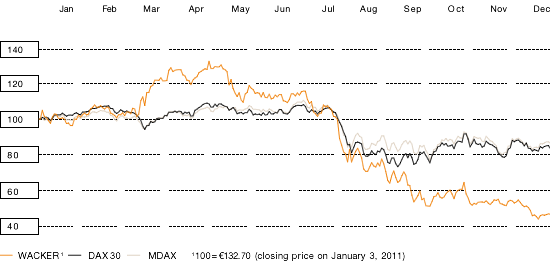After a slight dip to €125.85 at the start of 2011, WACKER’s stock rose to over €140 in response to preliminary figures released on January 31, 2011. When the early-March earthquake in Japan put capital markets under pressure, our stock went in the other direction. Since two major Japanese silicon-wafer manufacturers were forced to halt production, capital markets anticipated that WACKER’s order books, sales and EBITDA would benefit from the situation. Semiconductor orders did, in fact, increase. When the definitive figures for 2010 and the outlook for the first quarter of 2011 were released, our stock climbed to €167.70 in March, its highest level in almost three years.
The second quarter saw WACKER’s stock rising even further until early May, when it reached its high for the year at €172.80. The share price subsequently moved between €145 and €155 closing the second quarter at €149.10.
In early July, Europe’s sovereign-debt and banking crisis worsened considerably. The escalation was triggered by Greece, where the austerity measures already in place were insufficient to deal with the country’s combined budget and government crisis. Speculation on an Italian sovereign default, coupled with a hesitant crisis response by EU heads of state and government, led to great uncertainty on capital markets. Although the 17 eurozone countries agreed a second rescue package for Greece on July 21, 2011, the markets remained unsettled. A significant slowdown in the global economy played a role here, too. Germany’s two major indices, the DAX and MDAX, lost about 25 percent of their value in the July-through-September quarter – their biggest decline since fall 2002.
WACKER’s stock was not immune to this general capital-market downturn. At the same time, our stock was influenced by two further issues. The semiconductor market – including silicon-wafer business – deteriorated and, in the photovoltaic industry, late September brought market distortions. With overcapacity across the entire supply chain, severe price competition and strong consolidation pressures, a number of analysts heavily revised their previously positive forecast for the photovoltaic sector. As one of the world’s leading polysilicon manufacturers, WACKER was affected by the revision, which inevitably influenced our stock and diminished its attractiveness in the eyes of analysts and investors. At the end of the third quarter, WACKER’s share price closed at €67.25, having lost half of its value in just three months.
Due mainly to the adverse photovoltaic environment, WACKER revised its 2011 forecast downward when releasing its third-quarter figures in late October. Amid continued weak demand for silicon wafers in general, and 200 mm wafers in particular, the Executive Board then resolved to close the plant in Hikari (Japan) in 2012. We released an ad-hoc disclosure about this decision on December 8, 2011. WACKER’s stock price fell again, in response, to €57.49. It was quoted at €62.15 at the close of trading on December 30, 2011.
Overall, WACKER stock lost 53 percent of its value in 2011. In the same period, the MDAX lost 13 percent and the DAX was down 16 percent. The WACKER stock’s high for the year was €172.80 and its low €57.49.





